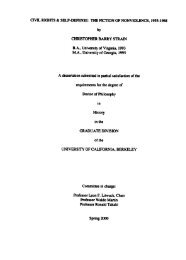Negro Digest - Freedom Archives
Negro Digest - Freedom Archives
Negro Digest - Freedom Archives
Create successful ePaper yourself
Turn your PDF publications into a flip-book with our unique Google optimized e-Paper software.
white families and a much lower<br />
level of family "stability ." Black<br />
people were twice as likely as<br />
whites to be unemployed, and consequently<br />
they had much lower income<br />
levels than whites . Over a<br />
fourth of the black families fell into<br />
the lowest income category as compared<br />
to a fifth of the white families,<br />
and in the higher income categories<br />
the whites consistently outstripped<br />
the blacks .<br />
Some rather profound changes<br />
had taken place by 1965 . The fertility<br />
level of the blacks was much<br />
closer to that of the whites as a<br />
consequence of a slight rise in white<br />
fertility and a large drop in black<br />
fertility. Black families were still<br />
characterized by more "problems"<br />
than white families, however, as<br />
only 78 percent of all black youth<br />
under 18 were living with both parents<br />
as compared to 90 percent of<br />
the white youth . The most significant<br />
change was in the unemployment<br />
levels . Black men were still<br />
twice as likely as white men to be<br />
without employment, but black<br />
women had a much lower unemployment<br />
rate, than white women .<br />
Finally, there was a considerable<br />
equalization in the distribution of<br />
families by income levels . It is true<br />
that more black than white families<br />
were in the lowest income category,<br />
but the difference between<br />
the two groups was reduced greatly .<br />
On the other hand, the difference<br />
in the proportion of families in the<br />
highest income category was increased<br />
in favor of the whites, while<br />
90<br />
in the middle-range categories the<br />
black and white families were almost<br />
equitably distributed.<br />
The general point we have been<br />
trying to articulate in this discussion<br />
of middle- and low-income<br />
black families in Cleveland, and<br />
their comparison to white families,<br />
is in answer to the question : if<br />
things have been getting better for<br />
some black people in the Sixties,<br />
what does getting better mean?<br />
The data would suggest that middle-income<br />
black families are<br />
out-distancing low-income black<br />
families in Cleveland, so in relation<br />
to each other the absolute and relative<br />
situation of middle-income<br />
blacks is getting better and that of<br />
low-income blacks is getting worse .<br />
However, in a comparison of<br />
middle-income blacks to whites in<br />
the same area, the data are suggestive<br />
if not conclusive . In 1960,<br />
middle-income black families were<br />
in a rather unfavorable position as<br />
compared to white families . By<br />
1965, the situation had improved<br />
for two possible reasons : (1) Many<br />
white families had moved out of<br />
the city in flight from the influx of<br />
black people, and those whites who<br />
remain behind may fall into the<br />
lowest and highest income categories,<br />
and (2) black women carried<br />
a considerable portion of the income-producing<br />
activities of black<br />
families, thus making it possible for<br />
their families to exist in some reasonable<br />
comparison to the white<br />
families who remained in the area .<br />
The situation for black men as<br />
March 1968 NEGRO DIGEST
















